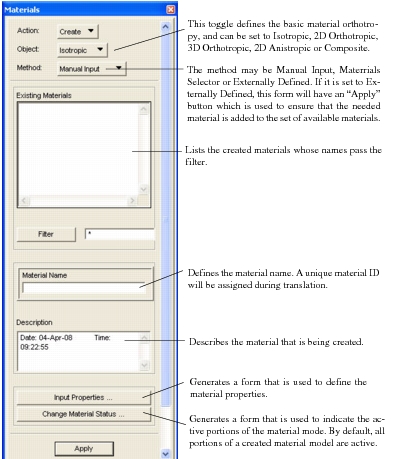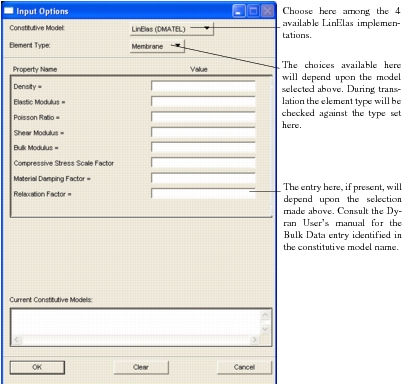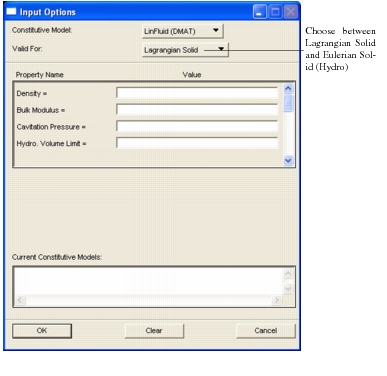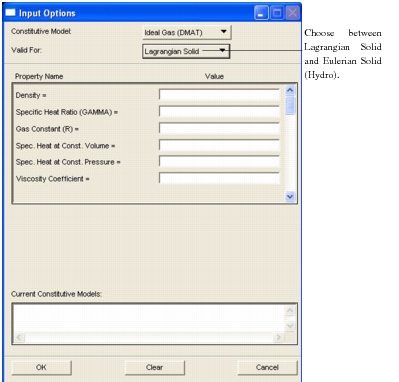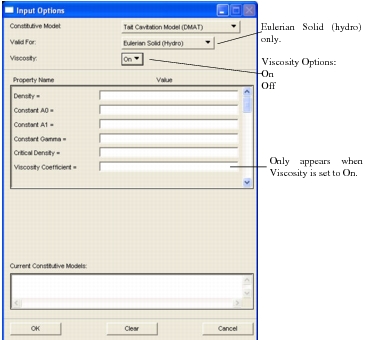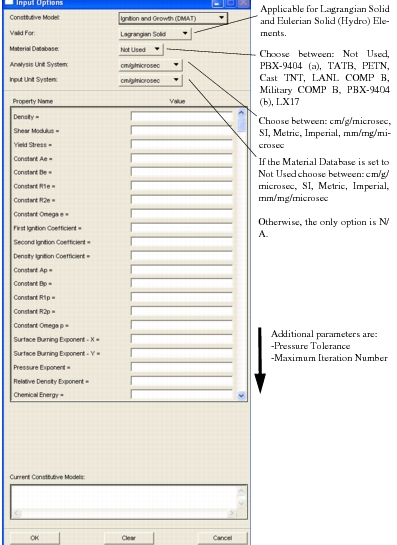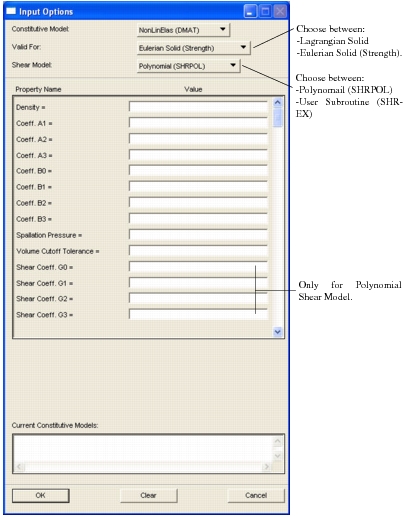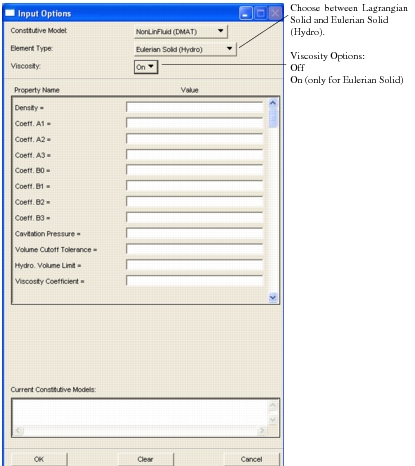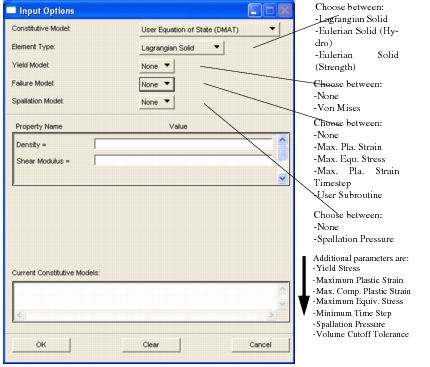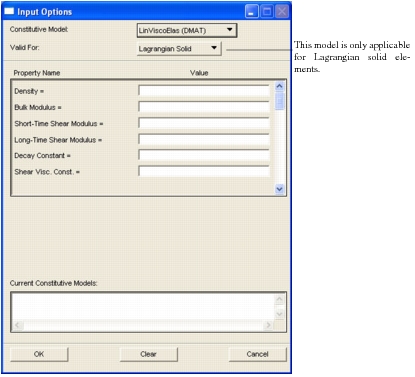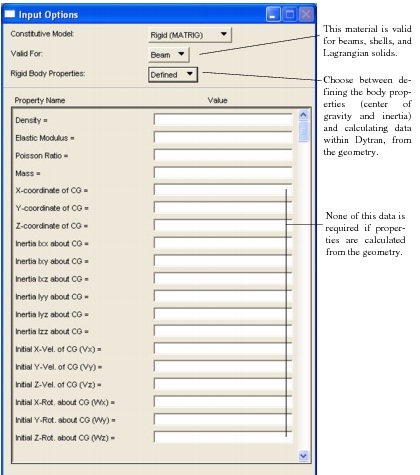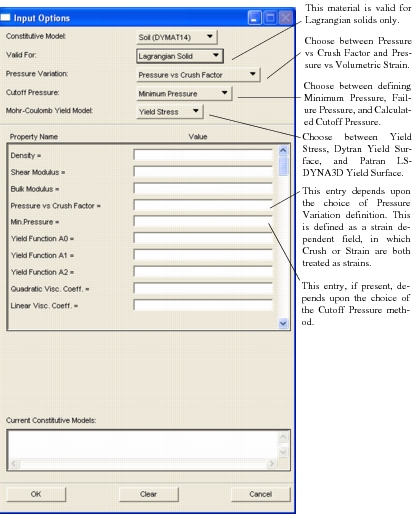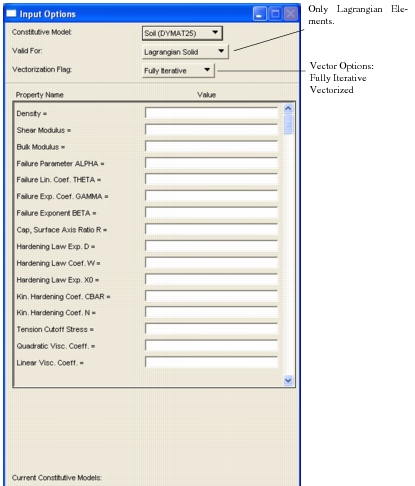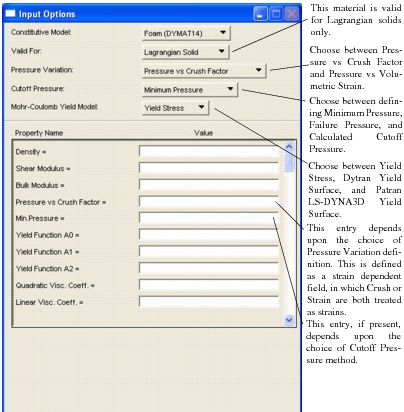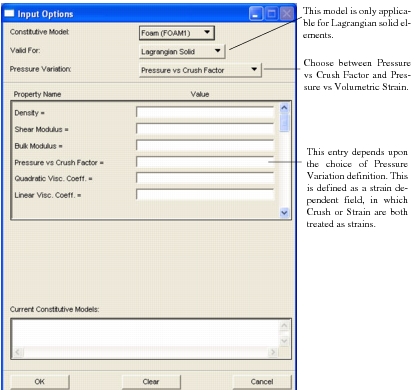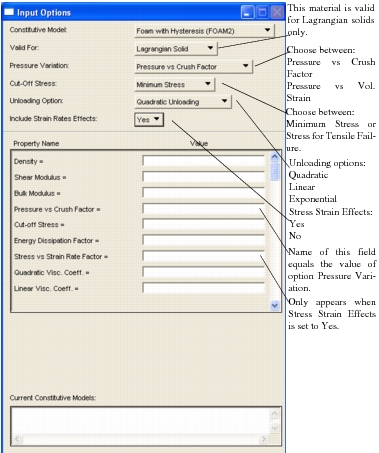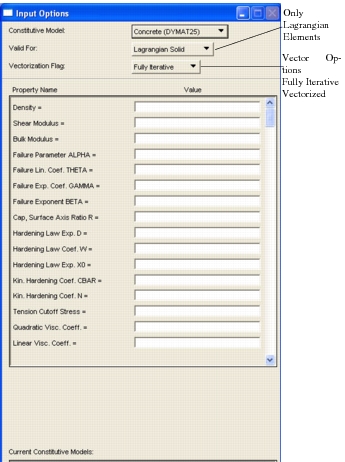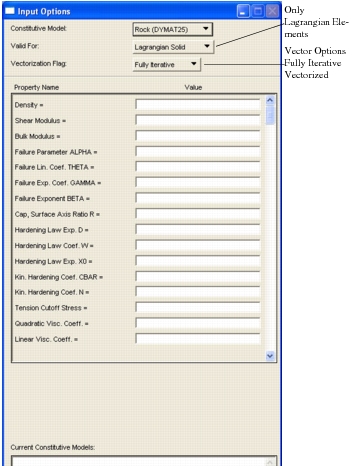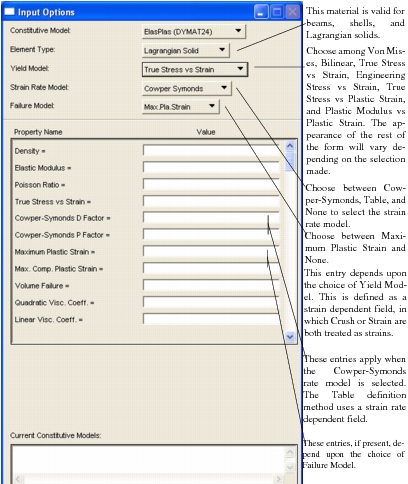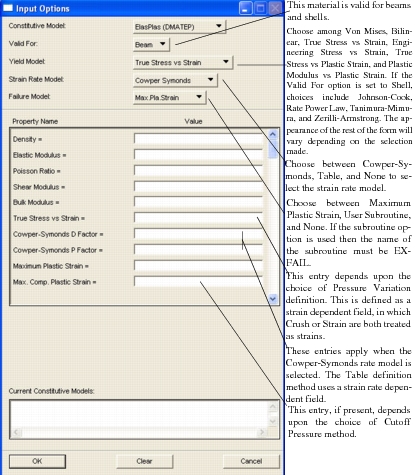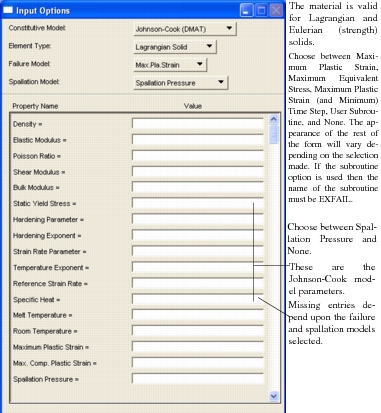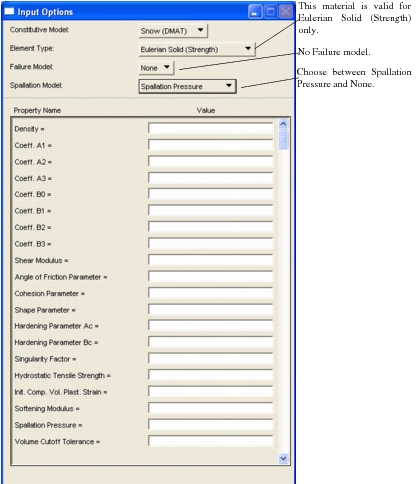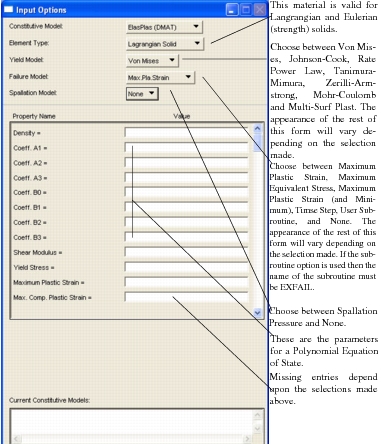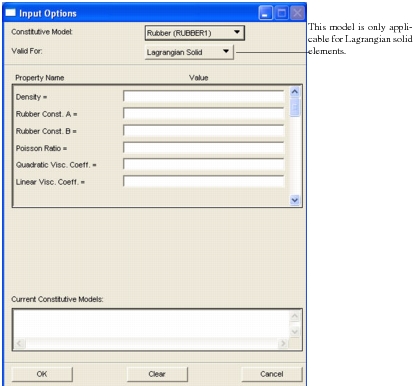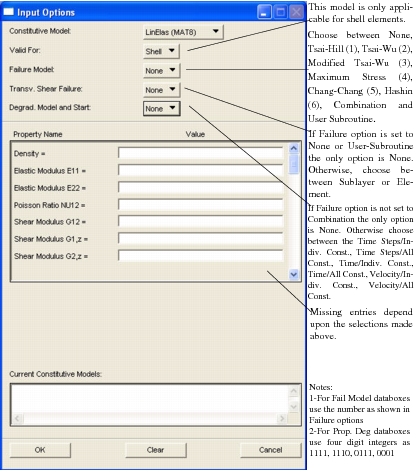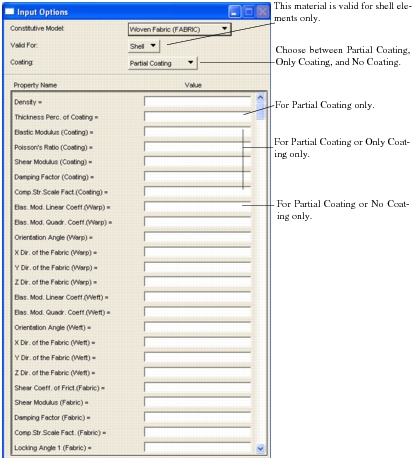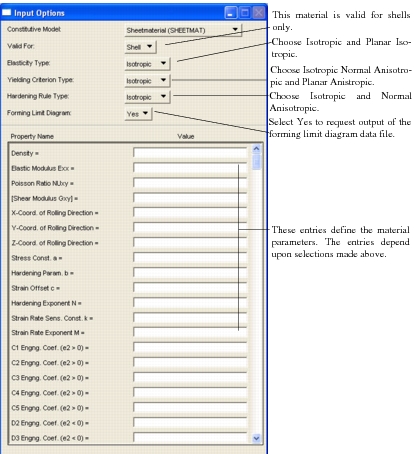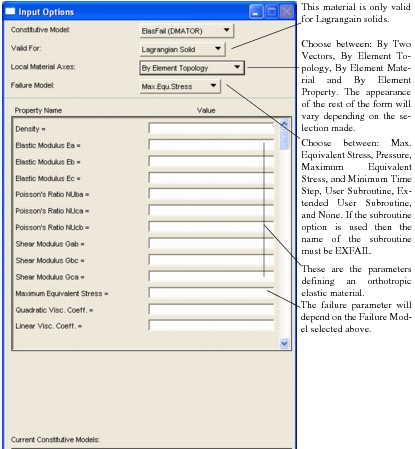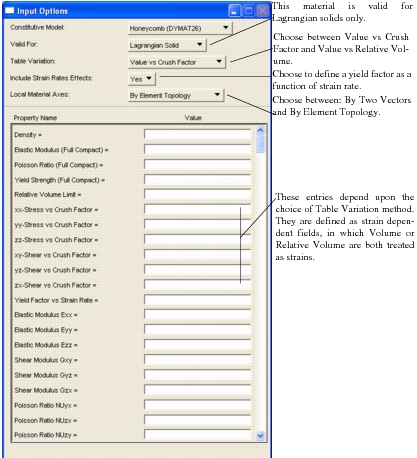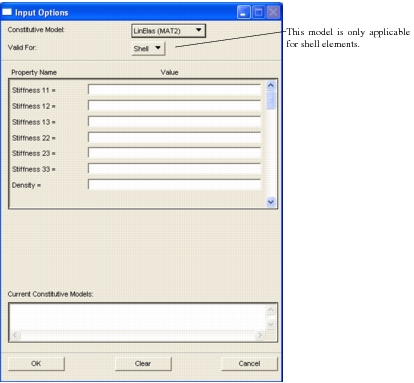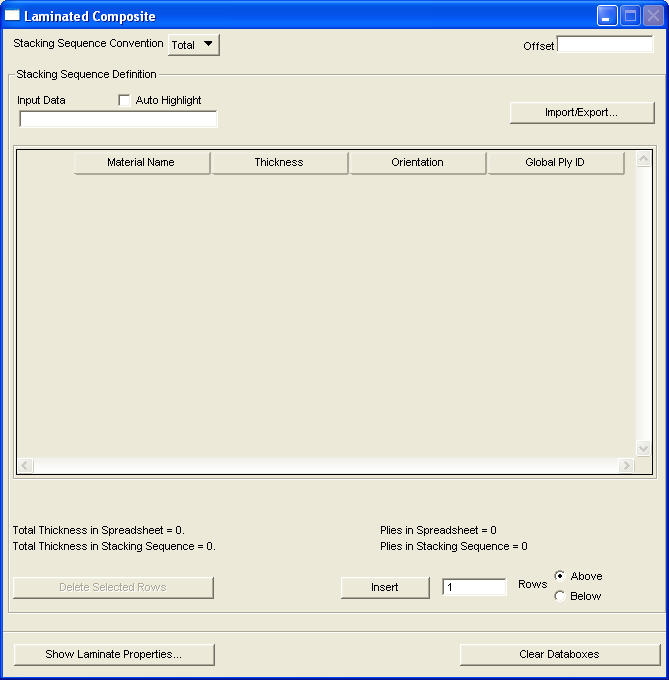XXXXXXXXXXXXXXXXXXXXXXXXXXXXXXXXXXXXXXXXXXXXXXXXXXXXXXXXXXXXXXXXXXXXXXXXXXXXXXXXXXXXXXXXXXXXXXXXXXXXXXXXXXXXXXXXXXXXXXXXXXXXXXXXXXXXXXXXXXXXXXXXXXXXXXXX''"> Material Library
The Materials form will appear when the Material toggle, located on the Patran application selections, is chosen. The selections made on the Materials menu will determine which material form appears, and ultimately, which Dytran material will be created.
The following pages give an introduction to the Materials form, and details of all the material property definitions supported by the Patran Dytran Preference.
Only material records which are referenced by an element property region will be translated. References to externally defined materials will result in special comments in the Dytran input file, with material data copied from user identified files. This reference allows a user not only to insert material types that are not supported directly by the Dytran preference, but also to make use of a standard library of materials.
Materials Form
This form appears when Materials is selected on the main form. The Materials form is used to provide options to create the various Dytran materials.
The following table outlines the options when Create is the selected Action.
Table 2‑2 Object | Option 1 |
Isotropic | • LinElas (DMATEL) • LinElas (MAT1) • LinElas (DMATEP) • LinElas (DMAT) • LinFluid (DMAT) • Ideal Gas (DMAT) • Tait Cavitation Model (DMAT) • JWL Explosive (DMAT) • Ignition and Growth (DMAT) • NonLinElas (DMAT) • NonLinPlas (DMAT) • NonLinFluid (DMAT) • User Equation of State (DMAT) • LinViscoElas (DMAT) • Rigid (MATRIG) • Soil (DYMAT14) • Soil (DYMAT25) • Foam (DYMAT14) • Foam (FOAM1) • Foam with Hysteresis (FOAM2) • Concrete (DYMAT25) • Rock (DYMAT25) • Cowper-Symonds (DYMAT24) • ElasPlas (DYMAT24) • ElasPlas (DMATEP) • Johnson-Cook (DMAT) • Snow (DMAT) • ElasPlas (DMAT) • Rubber (RUBBER1) • Linear Elastic |
|
|
|
|
|
|
|
|
|
|
|
|
|
|
|
|
|
|
2D Orthotropic | • LinElas (MAT8) • Woven Fabric (FABRIC) • Linear Elastic |
3D Orthotropic | • Sheetmaterial (SHEETMAT) • ElasFail (DMATOR) • Honeycomb (DYMAT26) |
|
|
2D Anisotropic | • LinElas (MAT2) • Linear Elastic |
Composite | • Laminate |
Isotropic
Linear Elastic
This subordinate form appears when the Input Properties button is selected on the Materials form, when Isotropic is selected on the Material form, and when one of the LinElast options is the selected Constitutive Model on the Input Options form.
Option 1 | Option 2 |
Linear Elastic | MAT1 DMATEL DMATEP DMAT |
|
|
|
Use this form to define a linear elastic material using one of the 4 available Dytran descriptions.
Linear Fluid
This subordinate form appears when the Input Properties button is selected on the Materials form, when Isotropic is selected on the Material form, and when the LinFluid (DMAT) option is selected as the Constitutive Model on the Input Options form. Use this form to define a linear fluid material using the DMAT description.
Ideal Gas
This subordinate form appears when the Input Properties button is selected on the Materials form, when Isotropic is selected on the Material form, and when the Ideal Gas (DMAT) option is selected as the Constitutive Model on the Input Options form. Use this form to define an ideal gas using the DMAT description.
Tait Cavitation Model
This subordinate form appears when the Input Properties button is selected on the Materials form, when Isotropic is selected on the Material form, and when the Tait Cavitation Model (DMAT) option is selected as the Constitutive Model on the Input Options form. Use this form to define a Tait Cavitation Model using the DMAT description.
JWL Explosive (DMAT)
This subordinate form appears when the Input Properties button is selected on the Materials form, when Isotropic is selected on the Material form, and the JWL Explosive (DMAT) option is the selected Constitutive Model on the Input Options form. Use this form to define a JWL explosive material using the DMAT description.
Ignition and Growth
This subordinate form appears when the Input Properties button is selected on the Materials form, when Isotropic is selected on the Material form, and the Ignition and Growth (DMAT) option is the selected Constitutive Model on the Input Options form. Use this form to define an Ignition and Growth DMAT description.
Note: | If Material Database is not set to Not Used, the only available parameters are Shear Modulus, Yield Stress, Pressure Tolerance and Maximim Iteration Number. |
Non Linear Elastic
This subordinate form appears when the Input Properties button is selected on the Materials form, when Isotropic is selected on the Material form, and the NonLinElas (DMAT) option is the selected Constitutive Model on the Input Options form. Use this form to define a non linear elastic using a DMAT description.
Non Linear Plastic
This subordinate form appears when the Input Properties button is selected on the Materials form, when Isotropic is selected on the Material form, and the NonLinPlas (DMAT) option is the selected Constitutive Model on the Input Options form. Use this form to define a non linear plastic using a DMAT description.
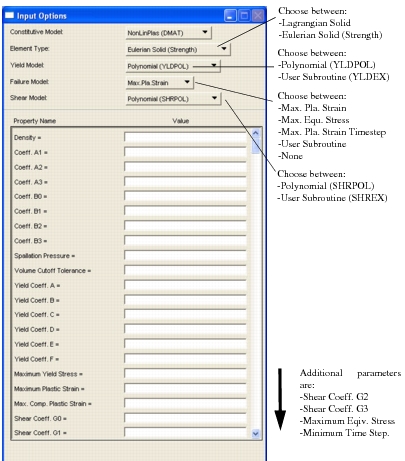
Note: | 1. When Element Type is Eulerian Solid, the only Failure options are None, Max. Pla. Strain and User Subroutine 2. Only show Maximum Plastic Strain for Failure options Max. Pla. Strain and Max. Pla. Strain Timestep 3. Only show Maximum Equivalent Stress for Failure option Max. Equ. Stress 4. Only show Minimum Time Step for Failure option Max. Pla. Strain Timestep 5. Only show Volume Cutoff Tolerance for the Element Type option Eulerian Solid 6. Only show Yield Coefficients for the Yield Model option Polynomial 7. Only show Shear Coefficients for the Shear Model option Polynomial |
Non Linear Fluid
This subordinate form appears when the Input Properties button is selected on the Materials form, when Isotropic is selected on the Material form, and the Non Linear Fluid (DMAT) option is the selected Constitutive Model on the Input Options form. Use this form to define a non linear fluid using a DMAT description.
User Equation of State
This subordinate form appears when the Input Properties button is selected on the Materials form, when Isotropic is selected on the Material form, and the User Equation of State (DMAT) option is the selected Constitutive Model on the Input Options form. Use this form to define a User Equation of State using a DMAT description.
Note: | 1. When Element Type is Eulerian Solid (both), the only Failure options are None, Max. Pla. Strain and User Subroutine 2. Only show Yield Stress for option Von Mises 3. Only show Maximum Plastic Strain for options Max. Pla. Strain and Max. Pla. Strain Timestep 4. Only show Maximum Equivalent Stress for option Max. Equ. Stress 5. Only show Minimum Time Step for option Max. Pla. Strain Timestep 6. Only show Spallation Pressure for option Spallation Pressure 7. Only show Volume Cuttoff Tolerance for Eulerian Solid (both) |
Linear Viscoelastic
This subordinate form appears when the Input Properties button is selected on the Materials form, when Isotropic is selected on the Material form, and the Linear ViscoElastic (DMAT) option is the selected Constitutive Model on the Input Options form. Use this form to define a linear viscoelastic material using a DMAT description.
Rigid
This subordinate form appears when the Input Properties button is selected on the Materials form, when Isotropic is selected on the Material form, and the Rigid (MATRIG) option is the selected Constitutive Model on the Input Options form. Use this form to define a rigid material using the MATRIG description.
Note: | Local coordinate system (CID) can be defined in the form under
Analysis -> Execution Control -> Add CID to MATRIG. |
Soil (DMAT14)
This subordinate form appears when the Input Properties button is selected on the Materials form, when Isotropic is selected on the Material form, and the Soil (DYMAT14) option is the selected Constitutive Model on the Input Options form. Use this form to define a soil using the DYMAT14 model.
Soil (DYMAT25)
This subordinate form appears when the Input Properties button is selected on the Materials form, when Isotropic is selected on the Material form, and the Soil (DYMAT25) option is the selected Constitutive Model on the Input Options form. Use this form to define a soil using the DYMAT25 model.
Foam (DMAT14)
This subordinate form appears when the Input Properties button is selected on the Materials form, when Isotropic is selected on the Material form, and the Foam (DYMAT14) option is the selected Constitutive Model on the Input Options form. Use this form to define a foam using the DYMAT14 model.
Foam (FOAM1)
This subordinate form appears when the Input Properties button is selected on the Materials form, when Isotropic is selected on the Material form, and the Foam (FOAM1) option is the selected Constitutive Model on the Input Options form. Use this form to define a foam using the FOAM1 model.
Foam with Hysteresis (FOAM2)
This subordinate form appears when the Input Properties button is selected on the Materials form, when Isotropic is selected on the Material form, and the Foam with Hysteresis (FOAM2) option is the selected Constitutive Model on the Input Options form. Use this form to define a foam using the FOAM2 model.
Concrete
This subordinate form appears when the Input Properties button is selected on the Materials form, when Isotropic is selected on the Material form, and the Concrete option is the selected Constitutive Model on the Input Options form. Use this form to define a concrete using the DYMAT25 model.
Rock
This subordinate form appears when the Input Properties button is selected on the Materials form, when Isotropic is selected on the Material form, and the Rock option is the selected Constitutive Model on the Input Options form. Use this form to define a rock using the DYMAT25 model.
Cowper-Symonds
This subordinate form appears when the Input Properties button is selected on the Materials form, when Isotropic is selected on the Material form, and the Cowper-Symonds (DYMAT24) option is the selected Constitutive Model on the Input Options form. Use this form to define an elastoplastic material using the Cowper-Symonds model using the DYMAT24 description.
ElastoPlastic
This subordinate form appears when the Input Properties button is selected on the Materials form, when Isotropic is selected on the Material form, and the ElastoPlastic (DYMAT24) option is the selected Constitutive Model on the Input Options form. Use this form to define the DYMAT24 model.
ElastoPlastic
This subordinate form appears when the Input Properties button is selected on the Materials form, when Isotropic is selected on the Material form, and the ElastoPlastic (DMATEP) option is the selected Constitutive Model on the Input Options form. Use this form to define the DMATEP model.
Johnson-Cook
This subordinate form appears when the Input Properties button is selected on the Materials form, when Isotropic is selected on the Material form, and the Johnson-Cook (DMAT) option is the selected Constitutive Model on the Input Options form. Use this form to define an ElastoPlastic material using the Johnson-Cook model using the DMAT description.
Snow
This subordinate form appears when the Input Properties button is selected on the Materials form, when Isotropic is selected on the Material form, and the Snow (DMAT) option is the selected Constitutive Model on the Input Options form. Use this form to define the Snow model using the DMAT description.
ElastoPlastic
This subordinate form appears when the Input Properties button is selected on the Materials form, when Isotropic is selected on the Material form, and the ElastoPlastic (DMAT) option is the selected Constitutive Model on the Input Options form. Use this form to define the DMAT model.
Rubber
This subordinate form appears when the Input Properties button is selected on the Materials form, when Isotropic is selected on the Material form, and the Rubber (RUBBER1) option is the selected Constitutive Model on the Input Options form. Use this form to define a rubber material using a RUBBER1 description.
2D Orthotropic
Linear Elastic
This subordinate form appears when the Input Properties button is selected on the Materials form, when 2D Orthotropic is selected on the Material form, and the Linear Elastic (MAT8) option is the Constitutive Model on the Input Options form. Use this form to define a linear elastic, orthotropic material using a MAT8 and MAT8A description.
Woven Fabric
This subordinate form appears when the Input Properties button is selected on the Materials form, when 2D Orthotropic is selected on the Material form, and the Woven Fabric(FABRIC) option is the selected Constitutive Model on the Input Options form. Use this form to define a woven fabric using the FABRIC model.
3D Orthotropic
Sheet Metal
This subordinate form appears when the Input Properties button is selected on the Materials form, when 3D Orthotropic is selected on the Material form, and the Sheet Metal (SEETMAT) option is the selected Constitutive Model on the Input Options form. Use the form on the following page to define a linear elastic, orthotropic plate material using a SHEETMAT description.
Elastic Failure
This subordinate form appears when the Input Properties button is selected on the Materials form, when 3D Orthotropic is selected on the Material form, and the Elastic Failure (DMATOR) option is the selected Constitutive Model on the Input Options form. Use this form to define an orthotropic elastic material, with failure, using the DMATOR description.
Honeycomb
This subordinate form appears when the Input Properties button is selected on the Materials form, when 3D Orthotropic is selected on the Material form, and the Honeycomb (DYMAT26) option is the selected Constitutive Model on the Input Options form. Use this form to define a honeycomb using the DYMAT26 model.
2D Anisotropic
Linear Elastic
This subordinate form appears when the Input Properties button is selected on the Materials form, when 2D Anisotropic is selected on the Material form, and the Linear Elastic (MAT2) option is the Constitutive Model on the Input Options form. Use this form to define a linear elastic, anisotropic material using a MAT2 description.
Composite and Laminate
This subordinate form appears when the Input Properties button is selected on the Materials form, and when Composite and Laminate are selected on the Material form. Use this form to define a linear elastic laminated composite material.


